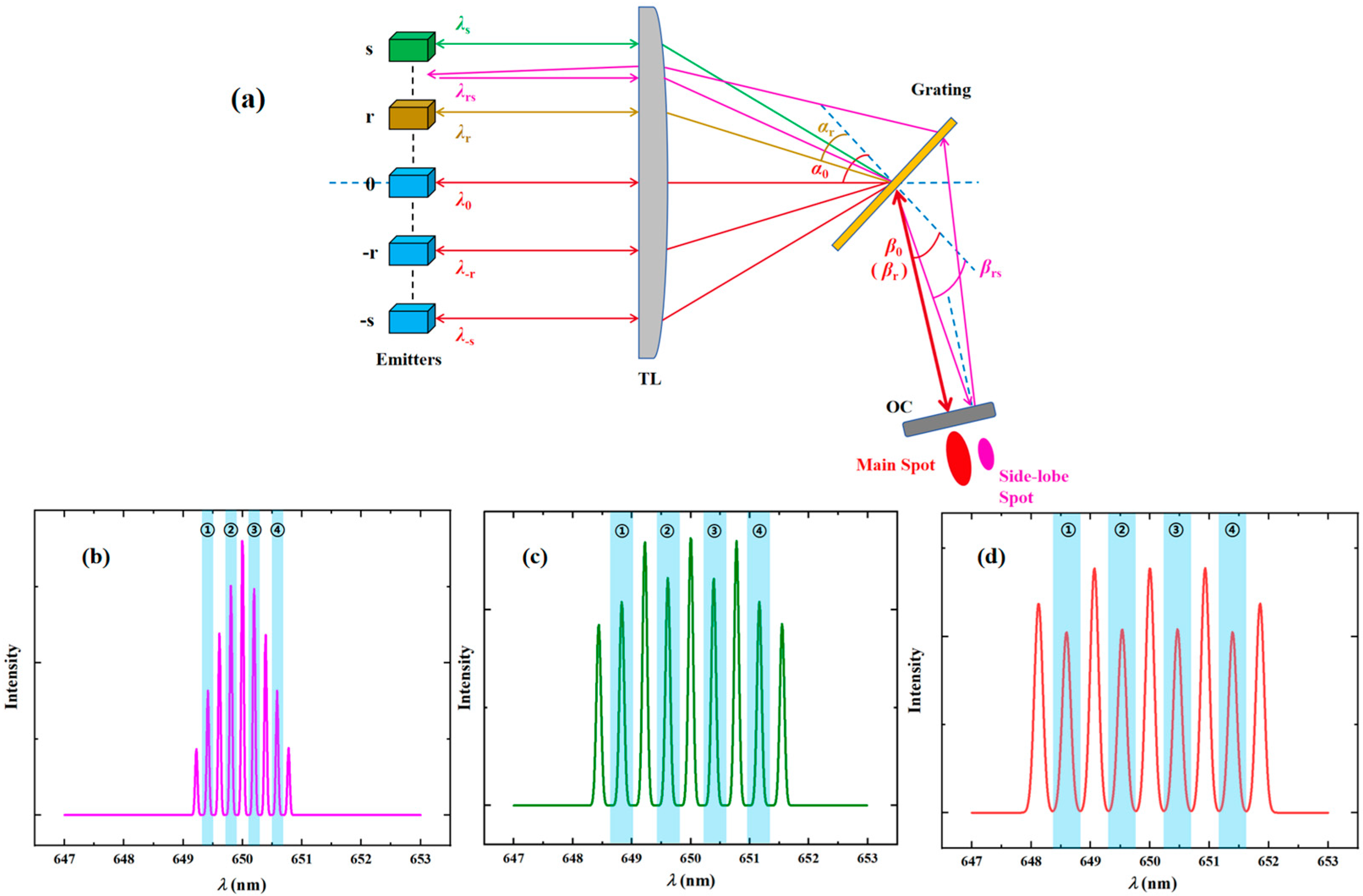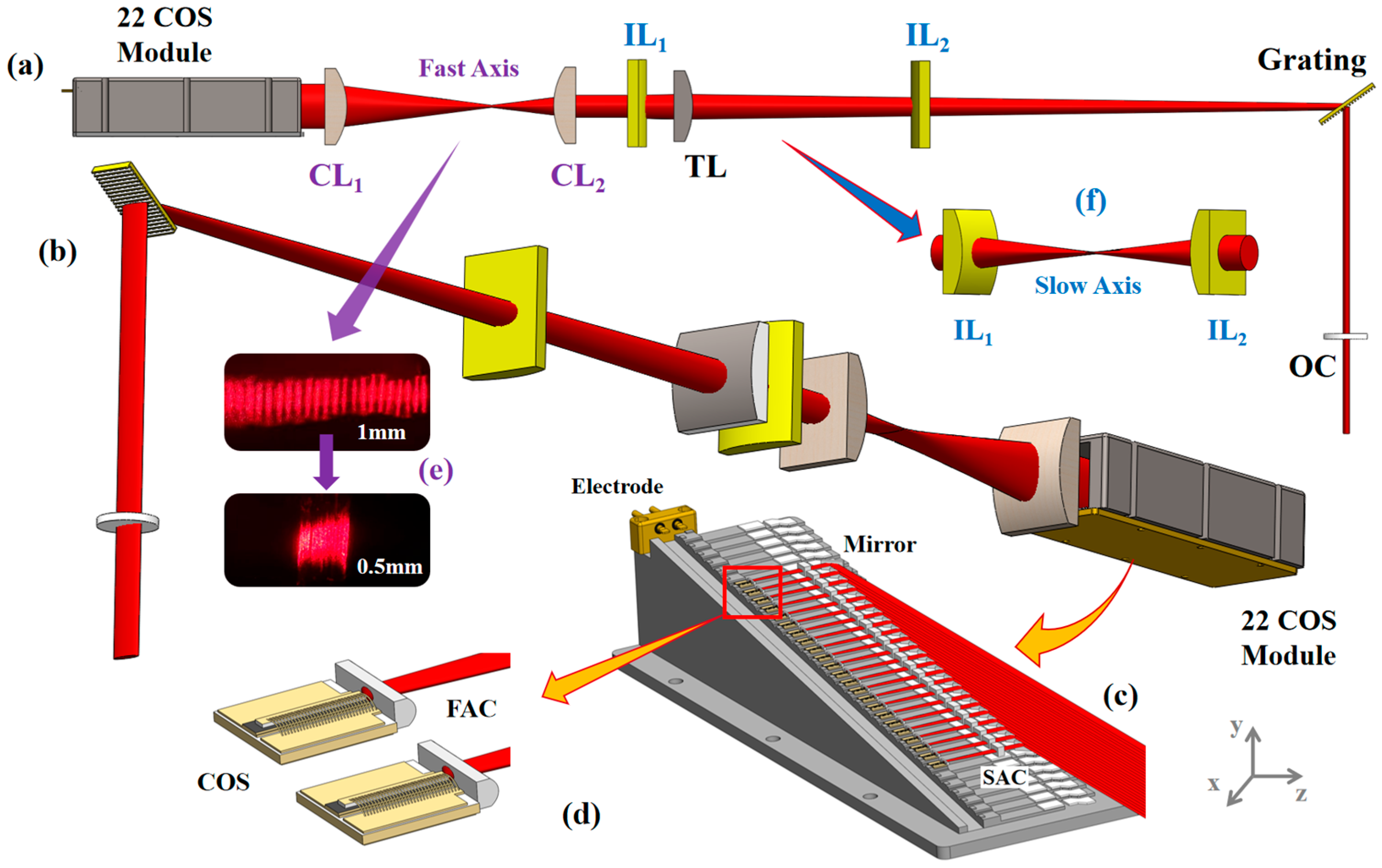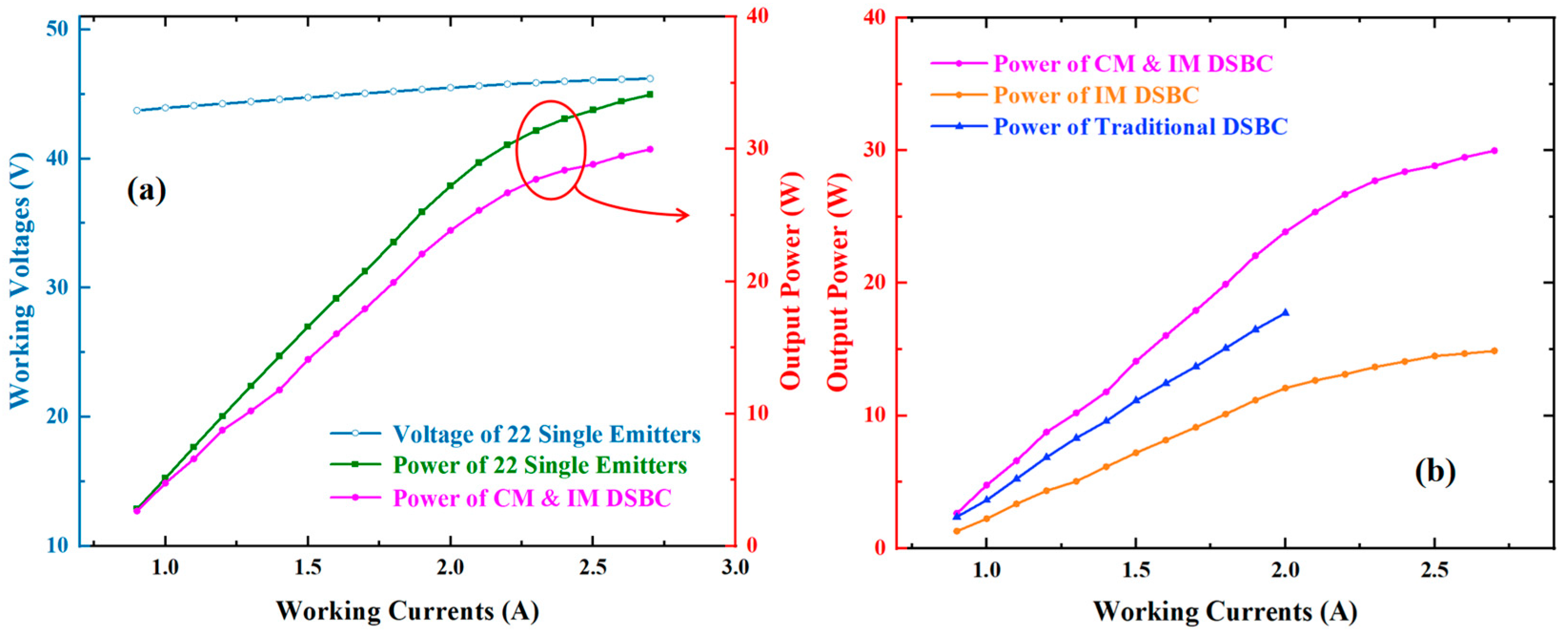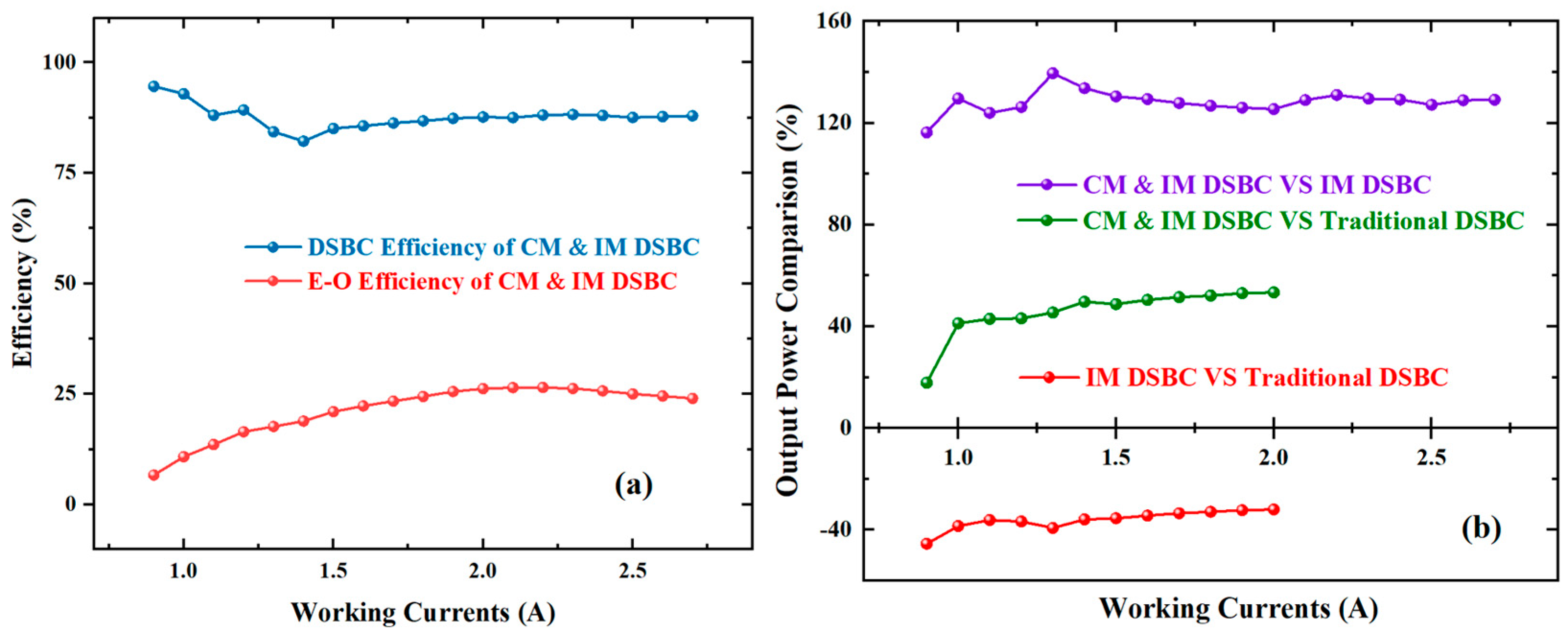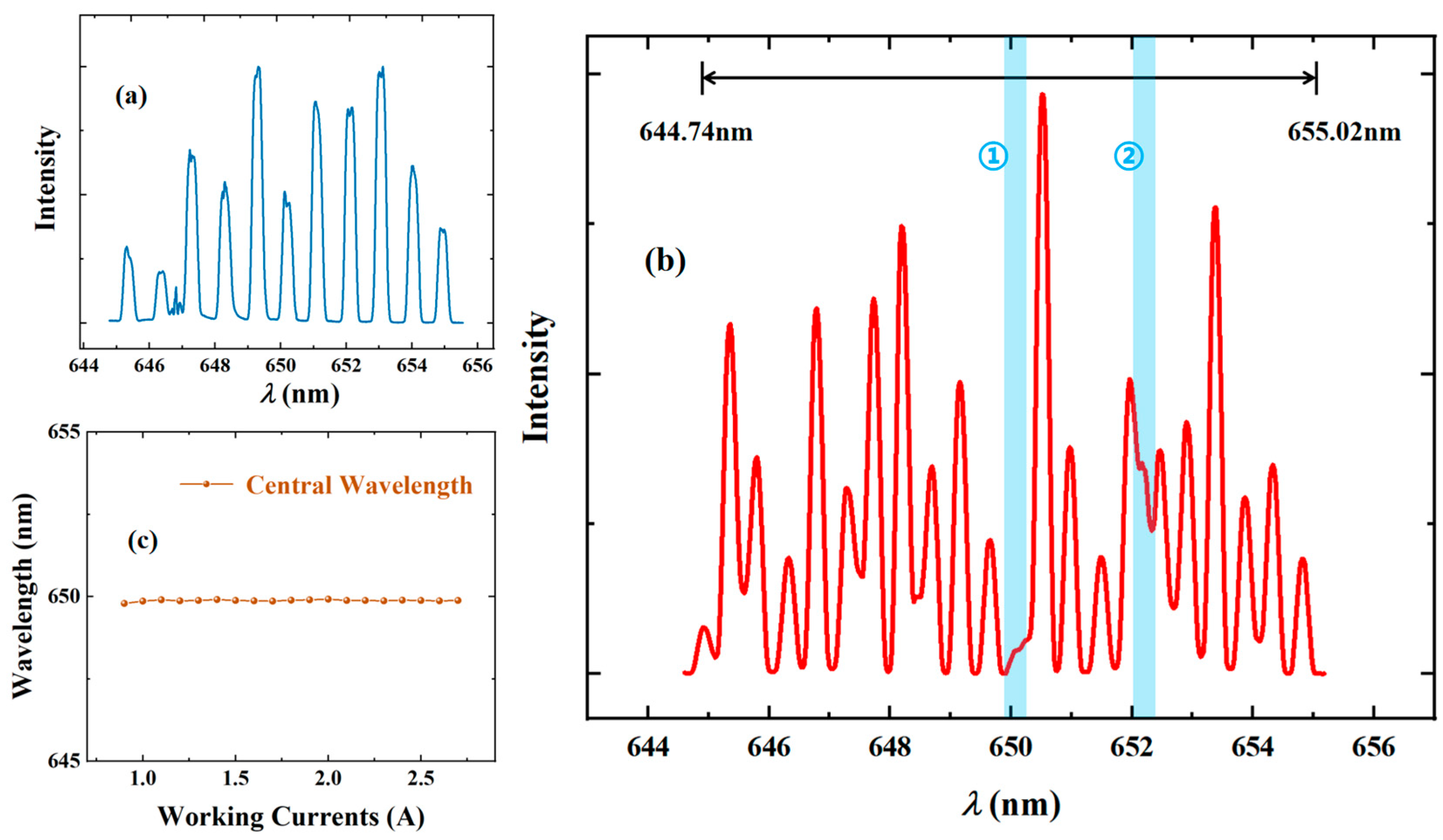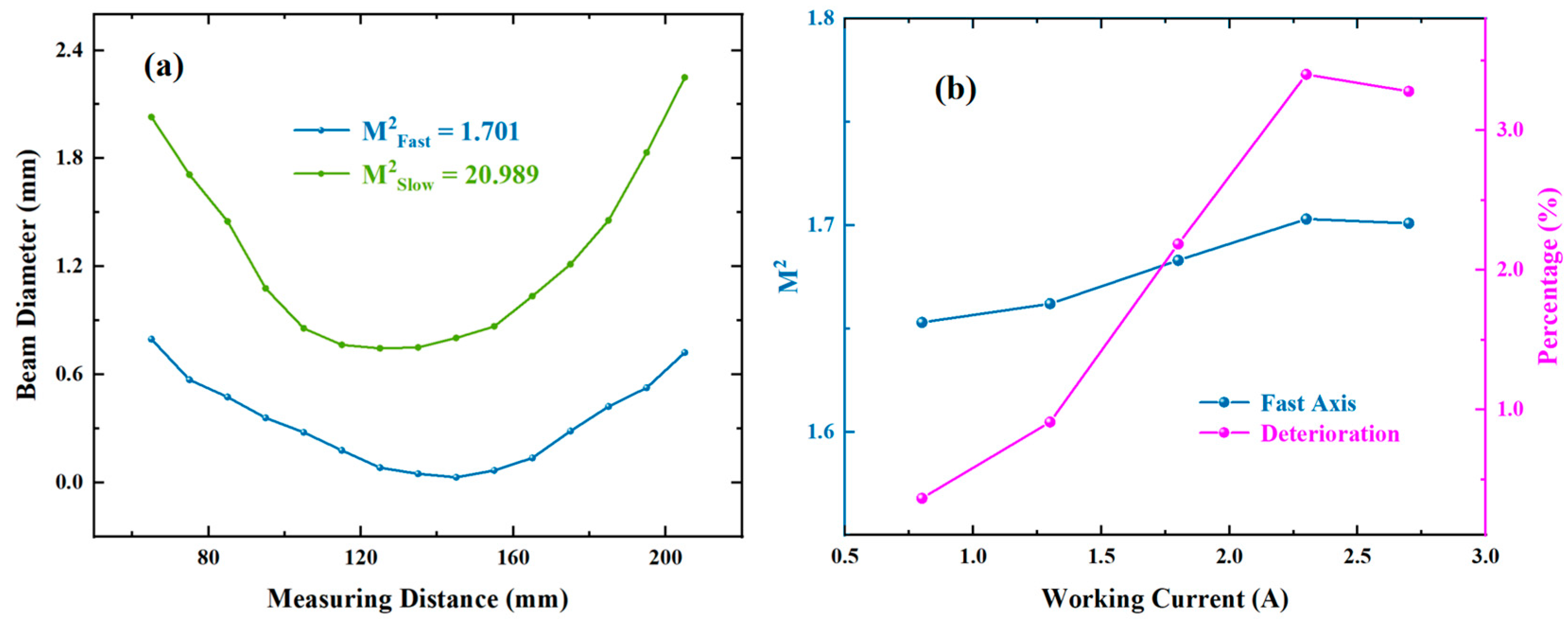2.1. 650 nm COS Single-Emitter and Simulation of Crosstalk Model
The semiconductor laser used in this experiment is a quantum well (QW) 650 nm COS (Chip on Submount) semiconductor laser single-emitter developed by Weifang Academy of Advanced Opto-Electronic Circuits. The internal laser chip structure of this single-emitter adopts an asymmetric waveguide design, with an active region size of about 1 μm × 100 μm and a centre wavelength (λ
0) of 650 nm. The main chip structure is shown in
Figure 1a. As can be seen from the figure, the quantum well (QW) layer, P waveguide layer, P cladding layer, N cladding layer, and N waveguide layer of this chip are all made of AlGaInP. The P contact layer and N contact layer are all made of GaAs. The thickness of the quantum well (QW) is about 8 nm. The package of this single-emitter is in the form of the COS (Chip on Submount), where the P-side is face-down on the brass heatsink. The operating performance of the 650 nm COS single-emitter is shown in
Figure 1b. The working voltage of this emitter is about 2 V, the threshold current is about 0.8 A, and the COD (Catastrophic Optical Damage) working current is 3.0 A. Therefore, the maximum current was set to 2.7 A in subsequent experiments. The output power of the single-emitter when the working current is controlled at 2.7 A is about 1.55 W. All the above data were measured at 25 °C in a water-cooled system, and the whole experiment was also conducted at this temperature. When the working current is 2.7 A, the divergence half-angles (the divergence angle at full-width at half-maximum) of the single-emitter in the fast-axis and slow-axis directions were 34.8° and 4.5°, respectively. The measured beam quality factors (M
2) in the fast-axis and slow-axis directions, M
2Fast and M
2Slow, were approximately 1.649 and 20.176, respectively. At 2.7 A, the free-running spectral width of the single-emitter was approximately 2 nm, with a total gain spectral width of 11 nm. The output surface of the 650 nm single-emitter was coated with a 0.5% antireflective film, and the rear cavity surface was coated with a 99.8% reflective film.
At present, the basic principles and mathematics of the dense spectral beam combining system have been the subject of international discussion, and were also elaborated in the previously published article [
18] of our study. Therefore, instead of expanding the basic structure and principles of DSBC in this paper, we directly provide a schematic diagram of the DSBC system in the presence of crosstalk phenomena. As shown in
Figure 2a, the blue dashed lines in the figure represent the optical axis as well as the optical normal of the grating and the output coupler (OC), respectively. In
Figure 2a, there are 2s + 1 COS semiconductor emitters, the focal length of the transform lens (TL) is
f, the diffraction grating period is Λ, and the spacing between each emitter is h. The visible red-light output from the central level 0th emitter has an incidence angle of α
0 and a diffraction angle of
β0 with respect to the grating normal. Based on the Littrow structure that is to be satisfied for DSBC, we know that the diffraction angles of all emitters, such as the -sth emitter, the -rth emitter, the rth emitter, and the sth emitter, are
β0. From this, we can determine the specific value of the Littrow angle corresponding to the system, as well as the final locked wavelength for each level (ith) of the emitters by using Equations (1) and (2):
In the absence of feedback crosstalk, the emitters of each level are locked to oscillate at the corresponding wavelength. (For instance, the rth level emitter is locked to oscillate at
λr.) In the schematic presented in
Figure 2a, we mainly show the crosstalk generated between the rth emitter and the sth emitter. Due to the divergence and deviation of the light source or the optical path, the output light of the rth emitter (brown line) may return to the sth stage emitter (green line) after being partially reflected by the OC. Eventually, a steady oscillating crosstalk light (pink line) is formed between the two emitters. According to the formula given in a related crosstalk paper [
19], we can conclude that the equivalent locked wavelength of the crosstalk beam can be obtained from Equation (3):
Since the beam is actually output from the rth emitter but is finally locked to a wavelength of
λrs, the crosstalk beam (pink line) is not entirely consistent with the Littrow structure through the diffraction grating. The diffraction angle of the crosstalk beam
βrs ≠
β0 results in an angle between the crosstalk beam (pink line) and the main combining beam (thick red line). Finally, as shown in
Figure 1a, the crosstalk beam forms a pink side-lobe spot next to the main red spot. The same occurs for other cases of crosstalk beams. In order to be consistent with the experimental structure we designed, we set the central wavelength
λ0 of the light source to be 650 nm, the spacing between the centres of the emitters to be 1 mm, and the grating period Λ to be 450 nm.
For the purpose of making the results clearer, we only set up five emitters in the simulations. The emitter levels were −2nd, −1st, 0, 1st, and 2nd. From the previous experimental results [
18], we know that the main reason for the initial existence of large crosstalk is the long optical path of the system. Thus, we first need to reduce the optical path of the whole structure, which requires us to choose a transform lens with smaller focal lengths. We use the simulation model to further simulate the TL with different focal lengths (600~100 mm). It is worth noting that the intensities at all levels are expressed using normalised intensities. Here, representative spectral results of 600 mm, 300 mm, and 250 mm are shown in
Figure 2b–d. The white background peaks in the figure represent the case of normal oscillation, while the light blue background peaks represent the case of crosstalk oscillation. It can be noticed that when the focal length is 600 mm, the intensity of the crosstalk oscillation is even greater than that of the normal oscillation. When the focal length is reduced to 300 mm, it can be observed that the crosstalk intensity is significantly weakened, indicating that reducing the focal length helps to weaken the crosstalk phenomenon. Further, when the focal length is reduced to about 250 mm, the crosstalk intensity is lower than the normal beam peak intensity. It is worth noting that each locking wave peak width is inversely related to the transform lens’s focal length. The longer the transform lens focal length, the narrower the locking wave peak width. Although further reducing the focal length of the transform lens can directly attenuate the intensity of crosstalk, we know through Equation (2) that the smaller focal length of the TL corresponds to the larger total spectral width of the combining beam. COS semiconductor lasers, on the other hand, have a fixed gain spectrum width, so the number of emitters that can participate in beam combining decreases, resulting in a significant decrease in the total output power. Therefore, we set the focal length of the converging lens to 250 mm, and the remaining crosstalk was solved by designing the imaging and compression telescope module (the specific principles and parameters will be described in the next section).
2.2. Experimental Setup
In this section, we will elaborate on the specific principles of the experimental system as well as the component parameters.
Figure 3a,b show the CM&IM DSBC system in the yoz planar schematic and 3D stereoscopic schematic. The system consists of four main modules. The first part is a 22,650 nm COS single-emitter module. In this case, the number of COS single-emitters is mainly determined using Equation (2) and the gain spectral width, which will be explained in detail later. The second part is a beam compression telescope module (purple). The third part is the imaging module (blue). The fourth part is the traditional DSBC module. The traditional DSBC module consists of a transform lens (TL), a diffraction grating, and an output coupler (OC). The transform lens is made of N-BK7, with a curvature radius of about 129.2 mm and an effective focal length of about 250 mm. The apertures of the TL in the diffractive (fast axis,
y) and non-diffractive (slow axis,
x) directions are 60 mm and 62 mm, respectively. The diffraction grating is a 2500 line/mm transmission diffraction grating from Gitterwerk, Germany, with a period Λ of 400 nm and a diffraction efficiency of about 93.5% for the TE-polarised (S) beam at 600~700 nm. The apertures of the grating in the diffractive (fast axis,
y) and non-diffractive (slow axis,
x) directions are 30 mm and 15 mm, respectively. The custom-made output coupler is 55 mm in diameter and coated with a 10% @ 600~700 nm reflective film on the laser-incidence side. Both side of the TL and the rear surface of the OC are coated with 99.8% @ 600~700 nm transmittance enhancement film. The internal structure of the 22 COS single-emitter module and the partial enlargement of the COS single-emitter are shown in
Figure 3c,d. As can be seen from the figures, 22 COS single-emitters are soldered to a stepped water-cooled brass base using silver-tin solder, with spacings between the fast-axis and slow-axis directions of 1 mm and 10 mm, respectively. Each COS single-emitter is collimated by an aspherical fast-axis collimator (FAC) with a focal length of 256 μm, and then by a slow-axis collimator (SAC) with a focal length of 20 mm. After this, they are reflected by a 7 mm total reflection mirror with a 45° position. Finally, all 22 collimated red laser beams are deflected by 90° and aligned in the fast-axis direction for output. The FACs, SACs, and reflection mirrors are fixed to the cooling base using UV adhesive and are made of fused silica. The front and rear surfaces of the collimators are coated with 99.8% @ 600~700 nm transmittance enhancement film.
A picture of the actual output beam spot of the 22 COS module before and after passing through the compression telescope module (CM) is shown in
Figure 3e. The telescope module consists of two spherical column lenses made of fused silica with effective focal lengths of 150 mm and 75 mm, respectively. The 150 mm lens was made of N-BK7 with a curvature radius of about 77.5 mm and an effective focal length of about 150 mm. The apertures of the 150 mm lens in the diffractive (fast axis,
y) and non-diffractive (slow axis,
x) directions were 100 mm and 90 mm, respectively. The 75 mm lens was made of H-K9L, with a curvature radius of about 38.8 mm and an effective focal length of about 75 mm. The apertures of the TL in the diffractive (fast axis,
y) and non-diffractive (slow axis,
x) directions were 53 mm and 50.8 mm, respectively. The converging direction of the column lenses was placed along the fast-axis direction, which achieved the purpose of reducing the beam spacing in the fast-axis direction by half. As can be seen in
Figure 3e, the output beam spacing of 1 mm was successfully reduced to 0.5 mm after passing through the compression telescope module, and it is worth noting that the difference in the size of each spot in the figure was due to the optical path difference in the stepped structure. Combined with Equation (2), we know that when the beam spacing h is reduced from 1 mm to 0.5 mm, the corresponding total spectral peak spacing is reduced by half. Therefore, at a constant gain spectral width, the number of COS single-emitters involved in the system can be doubled compared to those of the structure without CM. It should be noted here that the IM DSBC system represents the CM&IM DSBC system without the compression telescope module (CM). This solves the problem of the large reduction in output power associated with reducing the focal length of the TL. Taking the above parameters (h = 1 mm;
f = 250 mm; α
0 = 54.5°, Λ = 400 nm) into Equation (2), the peak-to-peak spacing of the spectrum was calculated to be about 0.93 nm. With a gain spectral width of 11 nm, the DSBC system without CM allows up to 11 COS single-emitters to participate in the process. Therefore, with the addition of the 1/2 beam compression telescope module, it is expected that 22 COS single-emitters should be involved in the beam combining process.
We know from the simulation results in the previous section that the crosstalk phenomenon still exists in the spectrum of the 250 mm transform lens. In the simulation, we can observe that when the focal length of the TL is less than 100 mm, the system will no longer experience the crosstalk phenomenon. When looking at the analysis of the principle of crosstalk phenomenon presented in the previous section and the actual experimental structure, the main reason for crosstalk in this structure is found to be that the beam is constantly dispersed in the direction of the slow axis, which leads to a larger spot size. Therefore, an additional imaging module (IM) is needed to reduce the optical path in the slow-axis direction by 150 mm, as shown in the 3D schematic of the imaging module in
Figure 3f. The imaging module consists of two 75 mm column lenses, consistent with the 75 mm lens in the CM. The converging direction of the column lenses is placed along the slow-axis direction to reduce the optical path of the whole system by 150 mm in the slow-axis direction. It is worth noting that the imaging module should normally be placed in front of the transform lens, but since the transform lens is optimally spaced at 250 mm from the 22 COS module and the CM occupies a total distance of 225 mm, the space before TL is not enough for a whole IM. Furthermore, it is important to keep all mirrors as far away as possible from the more fragile diffraction gratings. Therefore, in this imaging module, the first column lens was placed in front of the transform lens and the second column lens was placed behind the transform lens. Since the TLs converge in the fast-axis direction, they do not affect the imaging process in the slow-axis direction. The front and rear surfaces of the four column lenses in the CM and IM were coated with 99.8% @ 600~700 nm transmission enhancement film. All the experimental results are shown and analysed in the next chapter.

